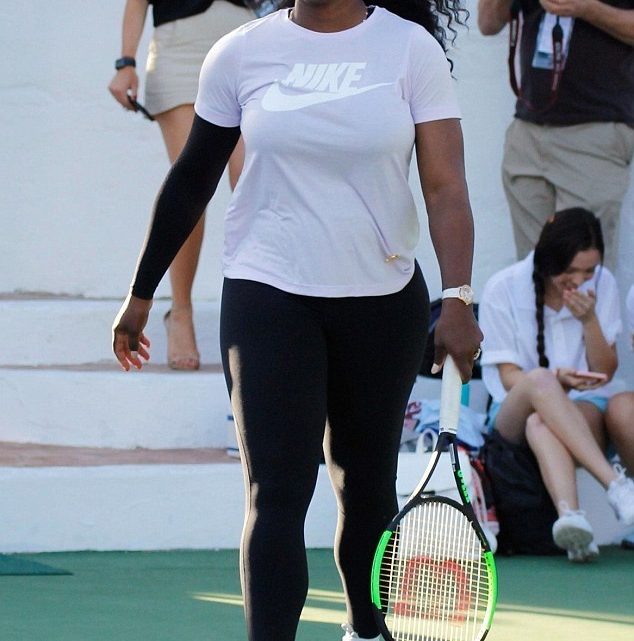
Serena Williams Can’t Force the Racism Out of Tennis
September 11, 2018Growing up in a posh Connecticut suburb I vividly remember driving by the tennis club and knowing this was a place I would never venture into. Tennis was not a sport for me—an uncoordinated chubby Black girl, and every image I had ever seen was of blonde, skeletal white ladies with pleated white skirts and bougie racquets.
All the kids I knew who did play tennis also embodied that cliche. I could not fathom that a girl that looked like me would pick up a racquet, let alone dominate the court. Then I saw Venus and Serena Williams and felt like Black girls could do anything, including tennis. However, history has shown us that it comes with a cost, which for the Williams sisters meant enduring years of microaggressive and systemic racism for daring to be the best in a traditionally white space.
This weekend’s US Open final became yet another example of the bias that has dogged Serena throughout her career after she was penalized by chair umpire Carlos Ramos for a coaching violation. The heated exchange culminated in Serena smashing her racquet, calling Ramos a “thief” explaining she doesn’t “cheat to win. I’d rather lose,” in addition to having an on-court argument with tournament director Brian Earley. The incident resulted in a deduction of points, the loss of a game and a fine of $17,000. It turns out that Ramos has a long history of rigidity when it comes to enforcing codes, but it was Serena herself who called out his leniency with male players who have behaved aggressively in the past.
What should have been a joyous, career-defining moment for Serena’s opponent and Grand Slam winner, 20-year-old Naomi Osaka (who proudly represents her half-Haitian, half-Japanese culture) was tarnished by confusion and emotion that further perpetuated the racism and sexism deeply rooted in the sport and highlighted the minimal progress achieved in making tennis a safe space for women of color. Osaka follows in Serena’s footsteps not just as a woman of color, but also as a player whose career will undoubtedly continue to be affected by racism and sexism.
In a post match interview, Serena spoke openly about the barriers she faced in this match and over the course of her career.
“I’m going to continue to fight for women and to fight for us to have equal [rights]. I just feel like the fact that I have to go through this is just an example for the next person that has emotions and that want to express themselves, and they want to be a strong woman, and they’re going to be allowed to do that because of today.”
After the upset, tennis legend Billie Jean King came to Serena’s defense, writing, “Women are treated differently in most arenas of life. This is especially true for women of color. And what played out on the court yesterday happens far too often. It happens in sports, in the office and in public service. Ultimately, a woman was penalized for standing up for herself.”
The Women’s Tennis Association (WTA) and U.S. Tennis Association have released statements voicing their support of Serena and concerns about sexism in the sport, while the International Tennis Association has chosen to back Ramos.
Marginalization of varying kinds is not uncommon in this sport. It is very rare for spectators to come across non-white players, especially when it comes to the Grand Slam. Since 1996, there have not been any men of color to enter into the finals as serious competitors, and it wasn’t until Serena and Venus Williams bounced onto the court with never-before-seen beaded braids and an unprecedented, yet well deserved, sense of confidence that we began to see non-white women dominate the sport.
But the question remains, why are people of color not prevalent within tennis? And once the Williams sisters retire, what will become of the marginalized demographics who succeed them? The average cost of raising a child to play tennis is approximately $54,750 annually. Yet according to the Bureau of Labor Statistics, the average household income of Black, Asian and Latinx families in the US is far below that amount, starting as low as $18,000.
Beyond being astronomically expensive, the culture of tennis has been historically racist, which creates barriers for people of color both as players and as spectators. What happened at the final this weekend became yet another example of the problems still rampant in the sport, as Osaka’s personal and professional triumph of not only playing but beating her childhood idol devolved into chaos, boos and a pervasive feeling of shame.
Throughout their career, the Williams sisters have persevered as various obstacles were thrown in their way by the organizations that control the sport. The racialized policing began early in their career, with a laundry list of microaggressions that include Venus being penalized in 1999 for her signature beaded braids coming undone during a match at the Australian Open, with headlines reading “Venus loses her head” and “Venus Unravels” all playing into the cliche of the angry Black woman. The sisters were then subjected to excessive drug testing, racist and transphobic banter, and the creation of new rules and regulations that were seemingly in direct response to their actions. The French Tennis Federation banned catsuits and the Women’s Tennis Association (WTA) created a regulation around players’ chosen headgear which affected the Williams’ ability to wear the protective styles many Black female athletes tend to favor. The WTA also changed their rules, requiring players to play four tournaments outside of the Grand Slam which forced Serena to play at a tournament she had made the decision to boycott 14 years prior after enduring racist heckling and accusations that she and her sister were rigging the games. After Saturday’s final, Serena faced another round of criticism, accusations of being a “sore loser,” which she has been called many times before, and was depicted in a blatantly racist cartoon showing a caricature with exaggerated dehumanized features across the court from a whitewashed version of Osaka.
But calling her a sore loser doesn’t address the systemic problems in tennis (and beyond) regarding how black women’s rage is viewed and demonized. Throughout the years she has managed to lose gracefully, doing so even on Saturday as she quieted boos from the crowd and comforted and congratulated a crying Osaka. That image is so powerful because it’s the embodiment of the unspoken sisterhood that women have used to support each other through centuries of harassment and persecution.
Serena Williams has undeniably paved the way for Black women and women of color in tennis, but the fact that Osaka’s first brush with greatness was tainted by the same racism and sexism that has plagued Serena throughout her 20-plus year career makes it clear there is more work to be done. The image of these two great women embracing and holding each other up should be a reminder that this is not a fight one person can win alone.
Follow Jagger Blaec on Twitter.


